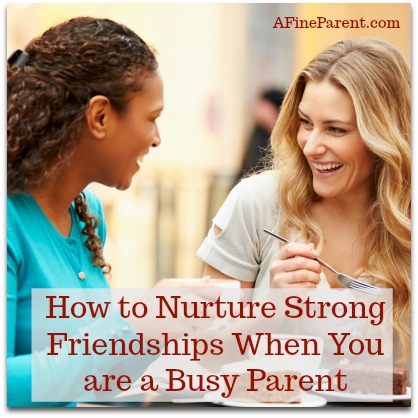 Close your eyes and imagine your child all grown up, savoring a free weekend. What do you see?
Close your eyes and imagine your child all grown up, savoring a free weekend. What do you see?
Is your daughter grabbing brunch with her pals? Is your son joining his pick-up basketball team on the court? Or perhaps you envision your kids enjoying a hike or a museum exhibit with a couple of close friends?
Regardless of what your vision for your child’s future involves, I bet it doesn’t include him or her sitting miserably at home, feeling lonely and friendless. As parents, we want our children to thrive socially, forming close bonds with their peers.
So, we encourage our children to make friends from the first years of their lives. We sign them up for baby classes and send them to preschool. We arrange playdates and nudge them towards other children at the playground. We tell them to share, organize group games, and teach conflict resolution skills to handle any inevitable skirmishes that arise between them and their new buddies.
But as we work to support our kids’ fledgling social lives, how many of us nurture our own friendships? How many of us are focused on our own social bonds with our own peers?
Too often, the responsibilities of work, home, and parenting take priority over our own social lives. We spend our days chasing down Hydra-esque To-Do lists – for every item we cross off, two seem to grow in its place.
We lose touch with friends who aren’t parents because they seem to be living in a different world. And we lose touch with friends who are parents because they’re as insanely busy as we are.
Making Friends for my Child’s Sake
A shy and awkward kid, I went through a lot of social drama. In school, I felt that no one understood me and often struggled to make friends. As a nerd, immigrant, and scholarship student at a fancy private school, I was objectively very different from my classmates.
But, in retrospect, I also had a challenging personality and lacked the social skills to build connections with my peers. My own parents, both introverts themselves, could not help me with these struggles.
When my daughter was born, I fervently hoped that she would have less trouble making friends than I had. I encouraged her to spend time with other children her age through classes, playgroups, and such.
But I soon realized the hypocrisy of my approach. How could I teach my kid to make friends if I weren’t doing the same? In fact, modeling healthy relationships was the most powerful tool I had as a parent to teach my daughter about friendship.
Making Friends for my Own Sanity
 In addition to modeling healthy social relationships for my daughter, I had another very good reason to prioritize my social life. In recent years, more and more parents have begun to recognize the essential role of self-care in good parenting.
In addition to modeling healthy social relationships for my daughter, I had another very good reason to prioritize my social life. In recent years, more and more parents have begun to recognize the essential role of self-care in good parenting.
To raise our children with patience, creativity, and wisdom, to calmly weather storms with toddlers or teenagers, to embody the role models we want to be for our kids, we must regularly replenish our own physical and emotional energy.
Self-care can take many forms, from meditation to fitness to pursuing our professional and personal passions. But it always involves one absolutely essential resource: strong friendships.
In recent years, many of the dire consequences of loneliness have come to light. Researchers have found that loneliness is more dangerous to our health than being overweight, and just as dangerous as smoking a pack of cigarettes a day. Let that sink in for a second. Loneliness can literally kill us.
For parents in particular, relationships matter. A recent study of 2,000+ mothers found that quality friendships were a significant determinant of their well-being, even more so than their marital relationships.
The authors of the study highlighted the potential of “close, authentic relationships [to buffer] women through the myriad challenges of motherhood”.
Stay-at-home parents are particularly vulnerable to the negative impact of loneliness. Often spending most of the day with their children, they have limited opportunities to communicate with other adults and fewer opportunities to cultivate meaningful friendships.
Working parents are not immune. In the modern workplace, heavy workloads and high turnover can make it difficult to form bonds with colleagues. In fact, research shows that anyone – young or old, single or married, employed or not – can suffer from loneliness.
Six Easy Steps for Making New Friends as a Parent (Even If You’re an Introvert)
 So, I’ve convinced you – your friendships are important for your and your child’s well-being. But where do you find friends? As an adult, meeting people is exponentially more difficult than it was in college.
So, I’ve convinced you – your friendships are important for your and your child’s well-being. But where do you find friends? As an adult, meeting people is exponentially more difficult than it was in college.
I know this firsthand: four years ago, I moved from New York to Houston, where I knew absolutely no one. I wanted to make friends, but I just didn’t know how. Plus, I had to overcome the additional obstacle of shyness, which did not help matters.
Fortunately, through trial and error, I figured out how to connect with other like-minded people, primarily parents with young children like myself. Here’s how I did it:
Look in the right places
Sure, sometimes a stranger chats you up in line at Whole Foods, and then it turns out you’re neighbors and your kids have the same birthday, and – boom – instant friendship.
But, outside the movies, that’s rare, so you’ll need to be a bit more proactive in searching for potential friends.
When I first moved to Houston, I explored the city and took solo walks in the park and even regularly visited Whole Foods, taking care to look friendly and approachable.
But, alas, a grand total of zero strangers approached me and asked to be my friend. So, six months later, I was still lonely.
Realizing that something had to change, I joined several local parent groups. I started actively reaching out to people and going to events. As an introvert, this was so difficult.
If I’m going to be honest, I have to admit that some of these meet-ups proved excruciatingly awkward. However, slowly but surely, my circle of friends grew.
Coincidence? I think not.
Choose the right people
Putting yourself out there is the first step to making new friends. But when you arrive at the music class or parent meet-up, you need to approach the right people for you.
The poised, charismatic woman holding court in the center of the room? That’s not who I was looking for. She might be nice – but she probably has a full social calendar and no time to cultivate a new friendship.
Instead, look for someone who’s on the periphery of the group. The one who’s a little shy or a little different or looks like she doesn’t know anyone. She’s much more likely to be looking for friends as well. And honestly? 90% of the time, they’ll turn out to be one of the coolest people in the room.
Take it to the next level
 How do you get from “person you see occasionally at playground” to “friend”? Ask for your acquaintance’s number, and then actually use it.
How do you get from “person you see occasionally at playground” to “friend”? Ask for your acquaintance’s number, and then actually use it.
As an introverted kid, I remember this part being a HUGE struggle for me. I would meet other kids who seemed nice, but totally chicken out when it came time to call or approach them and ask to hang out.
What if she doesn’t like me? I would think. What if she’s too busy? Of course, if the other person felt this way too, no one took the first step, and we both missed out on a potential friendship.
Fortunately, shy parents today have the infinitely less awkward option of texting a new acquaintance. So, send that text and see what happens. If nothing comes of it, don’t take it personally – all you’ve lost is a few minutes of your time!
Find your friendship routines
A parent’s life is busy. If you don’t explicitly make room for friendships to blossom, the cool people you meet will never become close friends and budding relationships will fade. Finding time to hang out is hard enough, but if you’re trying to coordinate with friends who have diametrically opposite schedules, that get-together might never happen.
So, when are you up for some socializing? Is it in the mornings with your children, when everyone’s up and full of energy? Or an adults-only get-together while the kids are in school or at sports practice? Or are Sunday afternoons prime hang-out time? Figure out what works best for you, and then connect with friends who want to hang out at the same times.
You don’t need a mommy tribe…
Ah, the mythical mommy tribe. We read about them, we see them in the movies – we even encounter them in real life, enjoying their weekly playdates and moms’ nights out.
Some moms put down roots in their hometowns and maintain close relationships with childhood friends. Others fall into a tribe – through their children’s school or their jobs or just by chance, they meet a group of women with similarly-aged kids who all get along.
If you’re part of a mommy tribe that makes you happy, that’s awesome. If not, don’t fret. The truth is that mommy tribes aren’t all they’re cut out to be. I’ve been in and out of a few, and it’s not some kind of social utopia.
Moms gossip and fight and annoy each other and get tired of doing the same things with the same people every week. Every social setup has pros and cons. So, focus on meeting people you enjoy spending time with, mommy tribe or not.
…but if you really want a mommy tribe, build one
Of all the people I’ve hung out with as a parent, my favorite a little group I formed myself. I made 3-4 friends, and then introduced them to each other. Similar temperaments will go a long way. Similar schedules are also important.
If all goes well, new friendships will be born and memories made. And, when everyone’s sitting on a patio having a cocktail and the husbands are chatting nearby and the kids are playing, you can think, “I created this,” and feel warm and fuzzy inside.
2-Minute Action Plan for Fine Parents
Go online and find a social event you can attend in your community in the next 1-2 weeks, either solo or with your kids.
You might sign up for a trial mommy & me class (or try a yoga or fitness class for yourself), visit a seasonal festival for families, go to a free event at the library, attend a workshop or mixer – the possibilities are endless!
You might even think of one friend you can invite to go with you!
The Ongoing Action Plan for Fine Parents
Set some clear goals so you don’t let your social life slip to the back burner.
If you’d like to make new friends, keep going to events where you can meet like-minded people who are also looking for friendship.
If there’s someone you’ve been meaning to get to know better, get her number and set up a get-together.
If you have friends but barely see them, aim to hang out with a friend (or group of friends) at least twice a week.
No matter what stage of the friendship journey you are on, keep yourself accountable. Put social events on your calendar and make them a priority.
Remember, you’re modeling essential skills for your children and building up the reserves you need to be a great parent – so don’t feel guilty about prioritizing that moms’ night out!
Oops, just saw photo of author, who does look like women pictured. Still think critique is valid and hope author is able to direct it to the right place.
@ Jane. Thanks for your thoughtful comment! I hope I don’t really look like those women in the stock photos (beyond sharing the same skin color)…and if I do, I need to give major props to my photographer friend for hiding my very real other-ness in my headshot.
As you mentioned, the authors don’t pick the images and I think the editors’ hands are also somewhat tied by what’s available in the stock photo libraries. The only solution I can imagine is creating alternative stock photo libraries at similar price points. A brief Google search tells me that this is starting to happen (for example, https://www.nappy.co/), but I think these stock photos still lean towards people who look upper-middle-class, so it only partially solves the problem. So we just need to find someone to start a stock photo business of working-class people in all shades of the rainbow…actually, this doesn’t sound like a half-bad business / nonprofit idea 😉
I know this is not the fault of the writer, but don’t know where else to give feedback. I wish the photographs had reflected the way the writer described herself. Immigrant, scholarship student, introverted. Rather than showing a bunch of what appears to be middle class white women having the time of their life. And yes, I know not all immigrants are People of Color and that the writer might have outgrown the hardships of childhood. I also know this blog sometimes shows photographs of People of Color. Who also seem to fit in the same demographics. I would just love to see photos of working class/poor families who are just as concerned about learning to be a fine parent. Liked the article – Haven’t seen this topic touched before.
Hi Jennifer! I think connecting with friends looks different for a stay-at-home (or work-from-home) parent than it does for a parent who works outside the home. Nevertheless, I do think finding two meaningful opportunities to connect with friends each week is a reasonable goal (unless someone’s an introvert and really doesn’t feel the need for such connection).
When I refer to connection, I don’t necessarily mean you need to organize some fancy group outing. During the week, you might:
*Have lunch or a coffee break with a friend from work (or a friend who works nearby)
* Arrange for a sitter or ask your partner/a relative to help so you can meet a friend for a drink after work
* FaceTime or chat on the phone with a friend after the kids’ bedtime (or, if kids are older, while they’re awake doing their own thing for an hour or so)
So the weekdays can cover one, if not both, of your “connection points”. Regarding the weekends, I might think about what exactly you’re prioritizing if you have multiple events each day. I see a lot of moms exhausting themselves on weekends running from birthday party to sports game to a social commitment they don’t really want to be at. Which of your commitments are truly necessary? Can you arrange carpools, or have your partner/a relative take your child to one of their weekend events? Also, many weekend activities come with built-in opportunities to develop friendships with other moms and have those moments of connection. If you’re chatting with other moms and enjoying yourself at that birthday party or sports game, that definitely counts 🙂
Final point: if you’re gung-ho about making this happen but your current friends are super-busy and don’t have the time, you should a) send them this article and b) find some new friends with less punishing schedules 😉
Just curious, can you tell me more about the twice a week comment? I’m an extrovert, working mom of two kids, and don’t consider myself lonely given all the friends we have. Twice a week sounds like a lot though…even though we have weekends planned with multiple things each day, especially when we have about 2 date nights a month. How can you fit that in? Thank you!
@Jennifer I replied to your question below – sorry, not sure why it didn’t register as a direct reply 🙂